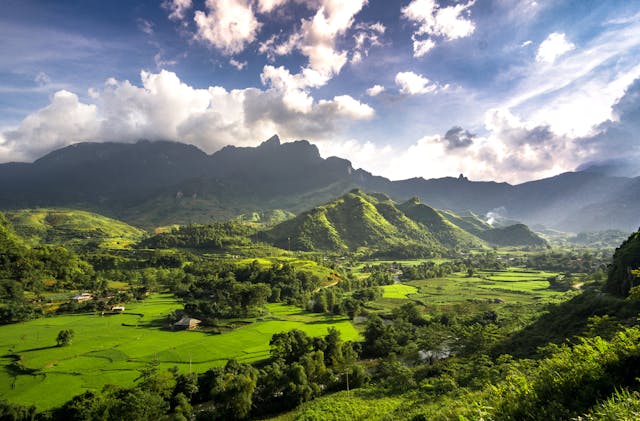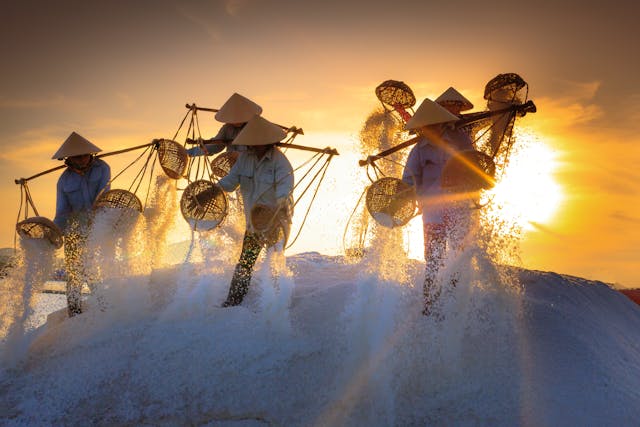Vietnam, a captivating Southeast Asian nation, is renowned for its rich history, vibrant culture, stunning landscapes, and delectable cuisine. From bustling cities to serene countryside, Vietnam boasts a wealth of treasures that have captured the hearts of travelers from around the world.
In this travel guide, we’ll delve into what Vietnam is famous for, highlighting its iconic landmarks, cultural heritage, natural wonders, and culinary delights.
1. Rich History and Cultural Heritage
Vietnam’s history is steeped in ancient traditions, dynastic rule, and colonial influence, leaving behind a legacy of cultural richness and diversity. Iconic landmarks such as the UNESCO-listed Imperial Citadel of Thang Long in Hanoi and the ancient town of Hoi An showcase Vietnam’s architectural splendor and historical significance.
The country’s vibrant festivals, including Tet Nguyen Dan (Lunar New Year) and Mid-Autumn Festival, offer insights into its cultural traditions and spiritual beliefs, while its diverse ethnic groups contribute to a tapestry of customs and folklore.
2. Breathtaking Landscapes and Natural Wonders
From the emerald waters of Ha Long Bay to the terraced rice fields of Sapa, Vietnam’s landscapes are as diverse as they are breathtaking. Ha Long Bay, a UNESCO World Heritage Site, is famous for its limestone karsts and pristine waters, offering opportunities for cruising, kayaking, and cave exploration.
The Mekong Delta, known as the “rice bowl” of Vietnam, is a lush expanse of rivers, canals, and floating markets, providing a glimpse into rural life and agricultural traditions.
3. Culinary Delights and Street Food Culture
Vietnamese cuisine is celebrated for its fresh ingredients, aromatic herbs, and balanced flavors, earning it a reputation as one of the world’s healthiest cuisines. Signature dishes such as pho (noodle soup), banh mi (Vietnamese sandwich), and fresh spring rolls showcase the country’s culinary diversity and creativity.
Street food culture thrives in Vietnam, with bustling markets and sidewalk stalls offering an array of savory snacks, sweet treats, and refreshing beverages. From steaming bowls of bun cha (grilled pork with noodles) to crispy banh xeo (Vietnamese pancake) and traditional mi quang noodles, Vietnam’s food scene is a feast for the senses.
4. Enduring Spirit and Resilience
Vietnam’s history is marked by periods of conflict and struggle, from colonial rule to the Vietnam War, yet its people have shown remarkable resilience and strength in the face of adversity. Sites such as the Cu Chi Tunnels and War Remnants Museum in Ho Chi Minh City offer insights into the country’s wartime experiences and the enduring spirit of its people.
Today, Vietnam is a thriving nation, with a rapidly growing economy, vibrant cultural scene, and a youthful population that looks toward the future with optimism and determination.

5. Vibrant Cities and Bustling Markets
Vietnam’s cities are vibrant hubs of activity, where ancient traditions blend seamlessly with modern innovation. Ho Chi Minh City, formerly known as Saigon, pulsates with energy, from its bustling markets and bustling streets to its gleaming skyscrapers and historical landmarks. Hanoi, the capital city, charms visitors with its tree-lined boulevards, ancient temples, and lively street food scene.
From the vibrant night markets of Hoi An to the bustling trade of Dong Xuan Market in Hanoi, Vietnam’s markets are a sensory delight, offering a glimpse into the country’s bustling street life and vibrant culture.
Conclusion: Vietnam’s Endless Charms
Vietnam’s fame extends far and wide, encompassing its rich history, stunning landscapes, vibrant culture, and delectable cuisine. Whether exploring ancient temples, cruising through scenic bays, or savoring street food delights, Vietnam offers a tapestry of experiences that captivate the imagination and leave a lasting impression on travelers.
Featured Image: Sand Dunes in Vietnam | Photo by Quang Nguyen Vinh
Read more Vietnam travel articles.

